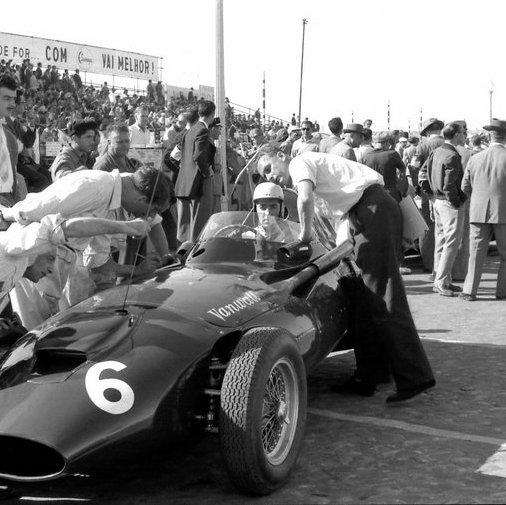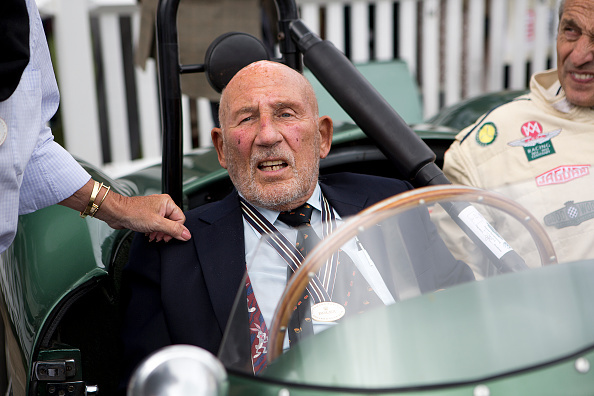Sir Stirling Moss OBE was definitely an interesting persona and the best driver not to win a championship. A British F1 driver, who raced in the early years of Formula 1. He won a total of 16 races in 66 starts and stood on the podium 24 times throughout the years 1951–1961, but sadly, never got to celebrate the Formula One World Championship. Stirling Moss finished 2nd in the driver’s championship four times in a row, between the years 1955-1958 and 3rd in the next three years between 1959-1961.
Early life of Stirling Moss
Sir Stirling Moss was born on 17th September 1929 and had racing in his veins and DNA. His father, despite being rather an amateur driver, competed in the Indianapolis 500 in 1924, and his mother was racing in hill races behind the wheel of an all-time classic Singer Nine. When Stirling was 5 years old, his sister, Pat Moss, was born, and later joined the family tradition of racing in the motorsports. Naturally, she competed in many rallies, including a Tulip Rally in the Netherlands, which she won, and Rally San Remo which she finished 2nd in a Lancia. When Stirling Moss was only 9 year old, he got his first car, an Austin 7, which he drove around the family-owned fields.
Racing CAREER
In 1951 Stirling Moss joined HMW, an established Aston Martin business. It turned out the car was not competitive at all. Despite having plenty of success in Formula 2, it wasn’t good enough for Formula 1. Nonetheless, Stirling Moss showed potential, and was approached by Alfred Neubauer, boss of the Mercedes-Benz, who suggested that Stirling Moss should get himself a Maserati 250F. The car was really fast, but struggled with reliability, which was a huge problem, and caused many DNFs, he used the shorter sessions of qualifying to showcase his potential, and qualified along the Mercedes drivers in the front.

Stirling Moss won his first race in 1955, after joining Mercedes, alongside his friend and mentor, Juan Manuel Fangio. During the British Grand Prix of 1955, Mercedes was in a class of its own, and took the whole podium and the 4th place as well. It was the first time, when Stirling Moss managed to beat Fangio, who was suspected of letting Moss have his first win in front of the home crowd. The Argentinian always denied it, and kept saying that Moss was simply better on that day. The 1955 was the first season, where Stirling Moss had the capability to compete for the World Driver Championship, but as in previous years, Fangio was impossible to catch and ended the season with almost twice as many points as 2nd Moss.
The 1956 season was extremely close, and Stirling Moss almost enjoyed winning the WDC. Still, almost was not enough, as he lost marginally to Juan Manuel Fangio, by 3 points. Due to the counting system, only 5 best races counted to the final total. For Sitrling’s opponent – Fangio it was 1st place in three races and 2nd in 2 races. But for Moss, who got second place twice and won a 3rd place, such a success wasn’t enough. Stirling Moss became the leading Mercedes driver, as Fangio moved to Ferrari, where he secured their 3rd title.
In the next season, Fangio once again changed the car, and switched to a Maserati. It was no surprise that he once again dominated the season. Stirling Moss didn’t start the year well, finishing only 8th in the opening round in Argentina and retiring from the race in Monaco. Despite winning the British Grand Prix, and then adding two more wins in the Pescara Grand Prix and the Monza Grand Prix, he didn’t stand a chance for the Championship. The Grand Prix in Pescara had a stunning 25km lap and is the longest circuit to ever appear in the F1 calendar (2.2km more than Nordschleife).

In the following year, Juan Manuel Fangio stepped down from racing in Formula 1, after achieving 5 World Championships and 2 second places in the 7 years of competing, It was also a time when Stirling Moss was the favourite to finally showcase his skills and claim the World Championship, racing in the Cooper-Climax. However, there was another British driver that appeared out of the blue and scored only 13 points in the previous year – Mike Hawthorn. The beginning of the season belonged to Moss, who won 2 of the 3 races, while Hawthorn finished 3rd, 5th and retired. Life is full of surprises, though, as in the second half of the year, the situation changed. Moss struggled with reliability and, in total, had to retire from 5 out of 10 starts, which ultimately cost him the Championship. The 1958 season was the first one, when the number of counted races increased from 5 to 6, due to an extended calendar. As a result, Stirling Moss had only 5 starts which counted, and even though he won 4 races and finished 2nd once, he lost the championship to Mike Hawthorn. The 1958 was successful for Hawthorn, who won only 1 race throughout the season, but still, had much better consistency. His 6 best results were places 1st, 2nd, 2nd, 2nd, 2nd, 2nd. Unexpectedly, he scored 1 more point than Moss.
The 1959 season was another unlucky one for Moss, who finished only 3 out of 8 races due to reliability issues, and finished the year in the 3rd position, behind Tony Brooks, and Jack Brabham. This was probably the last chance for Moss to get his hands on the Championship Trophy, as a year later, in 1960 the F1 has been dominated by two drivers from New Zealand, Jack Brabham and Bruce McLaren racing in the Cooper-Climax. The manufacturer won 6 out of 10 races, with 5 fins to the name of Brabham and a single victory to McLaren’s name. Once again, Moss changed the car and once again his previous manufacturer turned out to have an amazing year, while he struggled with the engine and reliability.
Life-threatening accident
Stirling Moss had an amazing pace, especially on one lap. However, due to bad luck, often had to retire from Grand Prix due to reliability issues (which were much more common in the 50s and 60s). The problem with Stirling’s “lack of luck” was that it had a tendency to struck harder than previously. At the Belgian Grand Prix he suffered a terrible accident due to axle failure, was thrown out of the car upon the crash and broke both his legs as a result. This crash was only a warning for the rest of the weekend. During the same weekend, Mike Taylor, a debutant, suffered a crash which ended his career, and two drivers lost their lives on track within 5 laps difference. The Belgian Grand Prix became one of the most tragic races in the history. For Stirling Moss, it was the end of the Championship fight, as he missed out on a total of 3 races. Thanks to his magnificent drive in the last race of the season, on the Riverside International Raceway, he managed to secure P3, despite missing on a big chunk of the season.
1961 was the last season of Stirling Moss behind the wheel of an F1 car. He won the opening round in Monaco, added a 4th place finish in the next race on the Zandvoort circuit. After that, his form dropped, and he didn’t finish higher than 8th until the 6th round of the Championship, which he won on the Nürburgring, once again proving his superiority on the complex and long circuits. 2 wins and plenty of DNFs’ didn’t let Moss fight for the Championship. Even with a mediocre season, he was able to finish the season among the top drivers and celebrated his 3rd consecutive P3 finish.
End of the career
On 24th of April 1962, less than a month before the start of the F1 season, Stirling Moss was participating in a Glover Trophy race on the Goodwood racetrack. He suffered a terrible accident in his Lotus and ended in a coma. All his bad luck finally turned into a good luck, when after a month of being in a coma, he was woken up.
Despite having the whole left side of his body paralysed, Stirling Moss started his recovery and after half a year was able to fully come back to his previous physical form. Despite being close to loosing his life, Stirling Moss tried coming back to racing, but decided it’s best to finally retire from Formula 1 after an unsuccessful test in which he lapped much slower than a year before. However, this wasn’t the end of this racing career, as he participated in numerous races after 1962, including a famous London-Sahara-Munich Rally.

Sir Moss has been an active person in the Motorsports industry, and has been awarded numerous honours, including being knighted in the year 2000 by Prince Charles as well as an FIA gold medal for his contribution to the motorsports. Moss died peacefully on April 13th, 2018, aged 90.
Currently, many people see Charles Leclerc as the potential Stirling Moss of our era. The Monegasque driver is an excellent qualifier, and has already accumulated 22 Pole Positions, more than Stirling Moss throughout his career. Still, Leclerc won only 5 races, often due to reliability issues, Ferrari strategic mistakes or his own driving errors. Leclerc is considered to be one of the best drivers of the last decade, but if he does not manage to win the Championship at least once, he will join Sir Stirling Moss in the infamous club.

